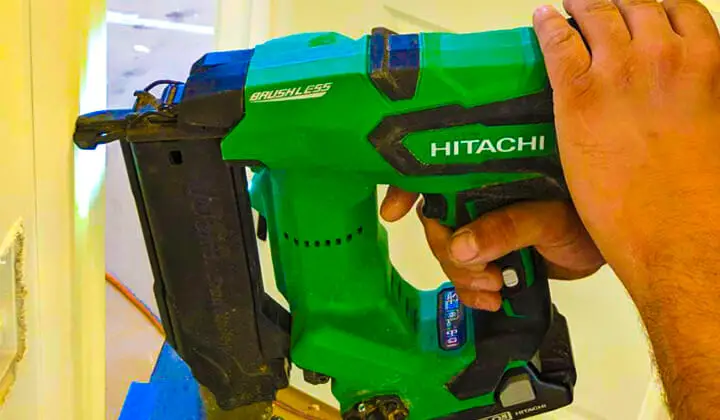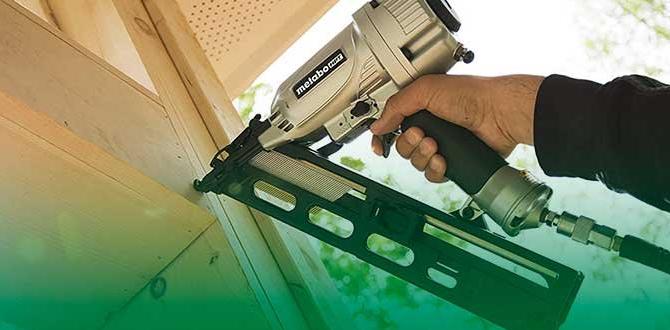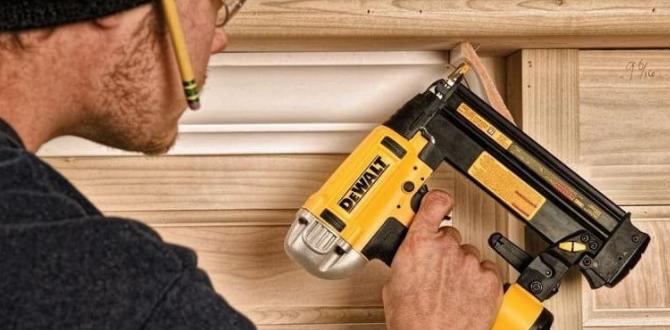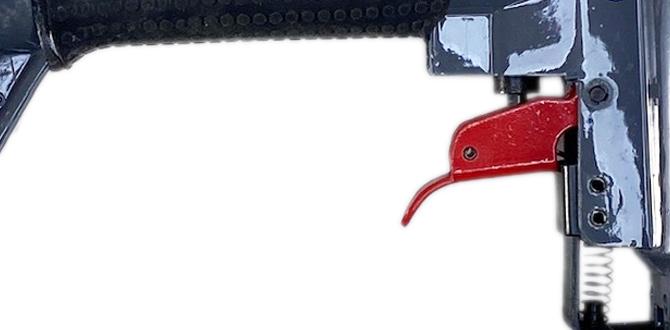Have you ever wondered what the best tool is for your next woodworking project? You might have heard of a pin nailer, a brad nailer, and a finish nailer. Each tool has its own special purpose. But how do you know which one to choose?
Imagine you want to build a birdhouse. A pin nailer would be perfect for tiny details without leaving big holes. However, if you need a stronger hold on the sides, a brad nailer might be better. And for finishing touches, a finish nailer would do the job well.
Did you know that using the right nail gun can make your project easier and faster? Picking the wrong one could lead to a struggle instead of success. In this article, we will explore the differences between a pin nailer, a brad nailer, and a finish nailer. By the end, you’ll know exactly which tool fits your needs. Are you ready to find out the best option for your next DIY adventure?
Table of Contents
Pin Nailer vs Brad Nailer vs Finish Nailer
Pin nailers, brad nailers, and finish nailers each have unique purposes in woodworking. Pin nailers are great for delicate work, as they use very thin nails. Brad nailers are slightly thicker and perfect for trim or molding. Finish nailers deliver strong nails for heavier projects like cabinets. Choosing the right tool can make your DIY projects smoother and more enjoyable. Surprised by the differences? Understanding these tools empowers you to tackle any project with confidence!
What is a Pin Nailer?
Features and specifications of a pin nailer. Common applications and advantages.
A pin nailer is a handy tool that shoots tiny nails, or pins, into wood. It’s perfect for delicate tasks like attaching trim or repairing furniture. Unlike bigger nailers, it leaves minimal marks, so your projects look clean and polished. These tools usually range in length from 23 to 18 gauge. It’s great for fine detail work without splitting the wood! Imagine giving your projects a neat finish without the extra ‘poke holes’—that’s the magic of a pin nailer.
| Feature | Description |
|---|---|
| Gauge Size | Typically 23 to 18 gauge |
| Common Uses | Trim work, crafts, and light assembly |
| Advantages | Minimal marks, great for fine finishes |
What is a Brad Nailer?
Key characteristics of a brad nailer. Typical uses and benefits of brad nails.
A brad nailer is a handy tool for many woodworking projects. It uses small nails called brads, which are thinner and shorter than regular nails. This makes them perfect for delicate work. Here are some key points to know:
- Lightweight: Easy to handle.
- Precision: Great for detailed tasks.
- Less splitting: Works well on thin materials.
Typical uses include attaching trim, molding, or small pieces of wood. The benefits of brad nails are that they leave tiny holes and are less noticeable. They help make your projects look neat and polished.
What are the advantages of using a brad nailer?
The advantages include quick assembly and strong holding power. They are easy to use and save time compared to traditional methods. Plus, they can reduce the risk of damaging your materials.
What is a Finish Nailer?
Description and technical details of a finish nailer. Scenarios where finish nailers excel.
A finish nailer is a powerful tool used for woodworking. It drives long, thin nails into wood. These nails are great for strong connections and a clean look. The finish nailer helps you avoid visible holes in the wood. It works best in these scenarios:
- Installing trim and molding
- Attaching cabinet doors
- Building furniture
This tool is perfect for jobs where a neat finish matters. It offers less chance of splitting the wood and makes your projects look professional.
What is the difference between a finish nailer and other nailers?
The main difference is the size of the nails they use. A finish nailer uses 16-gauge nails, while a brad nailer uses smaller nails. This allows finish nailers to hold things together more securely. Finish nailers are ideal when you want strong connections with a clean finish.
Comparative Analysis of Pin Nailer, Brad Nailer, and Finish Nailer
Size and type of nails used in each. Strength and holding power comparison. Pros and cons of each type.
When comparing nailers, size matters! Pin nailers use tiny nails, usually 23 gauge. They are great for delicate work but lack strong holding power. Then we have brad nailers, which use 18-gauge nails—stronger and perfect for light wood projects. Finish nailers, using 16 or 18-gauge nails, have the best holding power and are great for trim work. Here’s a quick table to sum it up:
| Nailer Type | Nail Size | Strength | Pros | Cons |
|---|---|---|---|---|
| Pin Nailer | 23 gauge | Low | Great for fragile projects | Not very strong |
| Brad Nailer | 18 gauge | Medium | Good for light woodwork | Can leave marks on some surfaces |
| Finish Nailer | 16 or 18 gauge | High | Strong and reliable | Heavier and bulkier |
Choosing the right nailer can be like picking the best pizza topping—it’s all about what you need! So, think carefully before you nail it down!
Choosing the Right Nailer for Your Project
Factors to consider when selecting a nailer. Project examples suited for each nailer type.
Choosing the right nailer can feel like a game of “which tool is better?” Knowing what you need makes it easier. First, think about your project. A pin nailer is great for delicate jobs like attaching trim. A brad nailer works well for small furniture. Use a finish nailer for stronger holds on bigger projects, like building a bookcase. Each has its place, so choose wisely!
| Nailer Type | Best Use |
|---|---|
| Pin Nailer | Delicate tasks (e.g., trim) |
| Brad Nailer | Light furniture assembly |
| Finish Nailer | Heavy-duty projects (e.g., bookcases) |
Cost Considerations and Budget
Average price range for each type of nailer. Longterm investment considerations.
Choosing the right nailer costs money. Pin nailers, brad nailers, and finish nailers all vary in price.
Here’s a quick glance:
- Pin nailers: Typically range from $50 to $100.
- Brad nailers: Usually cost between $70 and $150.
- Finish nailers: Can go from $100 to $300.
Think about the long-term value. A good nailer lasts many projects. Investing a bit more can save you time and hassle later!
What should I consider for my budget?
Consider the type of work you will do and how often you’ll use the nailer.
Key points to remember:
- Higher initial cost may equal better quality.
- Look for warranty and parts availability.
Maintenance and Care for Nailers
Maintenance tips for pin, brad, and finish nailers. Troubleshooting common issues.
Keeping your nailers in good shape helps them last longer. Here are some simple tips for all nailers:
- Clean your tools after each use to prevent dirt build-up.
- Check air pressure settings often for better performance.
- Lubricate moving parts every few months.
- Inspect for any damaged parts regularly.
If you run into problems, check if the nails are jammed or if there is low air pressure. Fixing these issues is often easy. Remember, a well-cared tool means better work!
What should you do if your nailer jams?
Clear the jammed nails carefully. Make sure the tool is unplugged or not connected to air. Then, follow the user manual for specific steps on resolving the jam.
Expert Recommendations and Reviews
Toprated models and brands for each type. Insights from professionals on usage and preferences.
Choosing the right tool can feel overwhelming. However, experts agree that picking the best models makes all the difference. For pin nailers, the Bostitch P6K3 is widely praised for its precision. When it comes to brad nailers, the Hitachi NT50AE2 stands out for its reliability. Lastly, the DEWALT DC618B finish nailer is a favorite among pros for its power. It’s like choosing a superhero for your home projects!
| Type | Top Rated Brand | Model |
|---|---|---|
| Pin Nailer | Bostitch | P6K3 |
| Brad Nailer | Hitachi | NT50AE2 |
| Finish Nailer | DEWALT | DC618B |
Professionals love using these tools because they make work easier and faster. Remember, the right choice means less frustration – and more time to binge-watch your favorite show!
Conclusion
In summary, choose a pin nailer for tiny projects, like attaching thin pieces. A brad nailer works well for lightweight materials, while a finish nailer is best for heavy-duty tasks. Each tool has its strengths, so think about your project needs. Try experimenting with different nailers, and check out more guides to find the perfect tool for your work!
FAQs
What Are The Main Differences Between A Pin Nailer, Brad Nailer, And Finish Nailer In Terms Of Usage And Application?
A pin nailer uses tiny nails called pins. You use it for small projects or delicate work. A brad nailer shoots a bigger nail called a brad. It’s good for attaching thin wood pieces. A finish nailer uses thicker nails. You use it for strong joints, like in furniture. Each tool works best for specific jobs!
Which Type Of Nailer Is Best Suited For Delicate Trim Work Without Splitting The Wood?
The best nailer for delicate trim work is a finish nailer. It uses small nails that don’t make big holes. This helps stop the wood from splitting. You can find electric or battery-powered models that are easy to use. Finish nailers help you make nice, smooth edges on your projects.
How Do The Sizes And Types Of Nails Used In Pin Nailers, Brad Nailers, And Finish Nailers Differ, And What Impact Does This Have On Projects?
Pin nailers use very small nails, usually 23 gauge. Brad nailers use slightly bigger nails, typically 18 gauge. Finish nailers use the largest nails, usually 16 or 18 gauge. The size of the nails affects how strong the hold is. Bigger nails work better for heavier projects, while smaller ones are great for delicate work.
Can A Brad Nailer Be Used Effectively As A Substitute For A Finish Nailer In Certain Woodworking Tasks?
Yes, you can sometimes use a brad nailer instead of a finish nailer for woodworking. A brad nailer uses smaller nails, so it works well for light projects. It won’t hold heavy pieces as well, but it’s great for thin wood and trims. Just remember, if you need strong support, stick with the finish nailer.
What Are The Advantages And Disadvantages Of Using Each Type Of Nailer For Home Improvement And Woodworking Projects?
Nailers help us put things together with nails quickly. A brad nailer is great for small jobs like trim work. It makes tiny holes that are easy to cover, but it can’t handle big projects. A finish nailer is stronger for bigger tasks, but it leaves bigger holes to fill. A box nailer is powerful for tough jobs, but it’s heavy and hard to control. So, choose your nailer based on the task you need!







